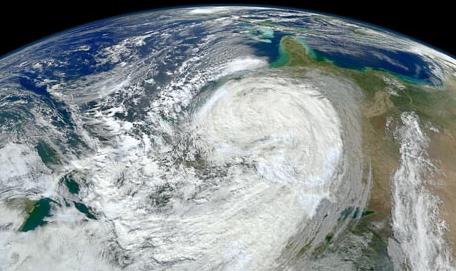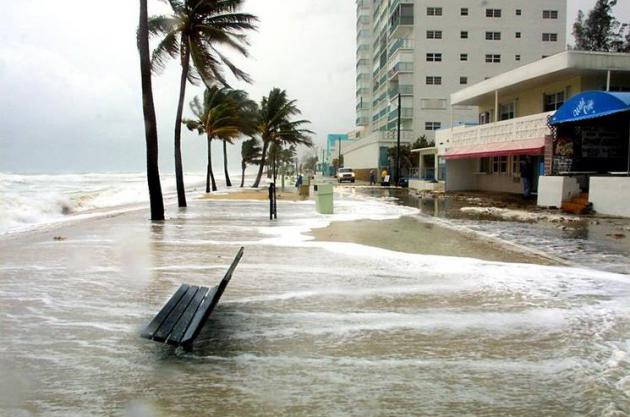40 F. average high on March 14.
61 F. high temperature on March 14, 2015.
.01" rain fell yesterday at KMSP.
Beware the (Rainy) Ides of March: 1-3" Rain, Ending as Slush
Beware the Ides of March. With a rapidly rising sun angle and huge north-south temperature extremes March can brew up wicked extremes: blizzards, floods, even tornadoes.
Any other March we might be looking at a cool foot of slushy, sloppy snow. Not this year. Temperatures are 15-20 degrees too warm. A rapidly intensifying storm tracking from Wichita to Madison will throw a shield of moderate rain into town today and tonight; the NAM model prints out 1.3" of precipitation - all rain.
By the time it's cold enough for snow the moisture will be long gone; maybe a fistful of flurries by Thursday. By late week it should actually feel like March, with upper 30s and low 40s - closer to average for this time of year.
Except "average" keeps changing over time.
Seasonably chilly weather spills into early next week, but long-range GFS guidance pulls a few more 50-degree days into Minnesota the last week of March. Nothing arctic brewing.
Our fast-forward spring means frost is leaving the ground quickly, but rapid run-off may flood a few roads later today. I predict a tricky commute later today.
March 15, 1941: The 'Ides of March Blizzard' occurs. Winds reached hurricane force at Twin Cities. 32 people died. Source: Twin Cities National Weather Service.



A Swing to La Nina Later in 2016? Not so fast - Miriam O'Brien at HotWhopper sent me this nugget from the Australian Bureau of Meteorology: "Based on the 26 El Niño events since 1900, around 50% have been followed by a neutral year, and 40% have been followed by La Niña. International climate models suggest neutral is most likely for the second half of the year. However, La Niña in 2016 cannot be ruled out, and a repeat El Niño appears unlikely."
Graphic credit: Guardian graphic | Source: NASA.
Image credit: NASA GISS, Mashable.
Breaking the Ice: Survival Lessons From a Changing Arctic. Audubon has a long and fascinating story focused on changes at the top of the world; here's a clip: "...Temperatures in the Arctic are rising twice as quickly
as the global average. Open water has led to greater erosion and bigger
storms. Diminished ice may be changing the polar vortex and other
large-scale weather patterns. The region is a global bellwether, and
while scientists on the Healy were focused on the practicality of
operating in the new north, their instruments would also track planetary
change. The buoys and gliders thrown overboard by NOAA would take
long-term measurements of wind speed, air temperature, humidity, cloud
coverage, solar radiation, water temperature, acidity, salinity,
dissolved oxygen, and many other environmental conditions—key baseline
data with global repercussions from a little-studied part of the Arctic.
The chemical sniffers, run by Dr. Jeffrey Welker,
a Fulbright U.S. Arctic Chair at the University of Alaska-Anchorage,
would sample isotopes from the air, drawing baselines of their own while
detecting spikes of carbon dioxide and another important greenhouse
gas, methane..."
Photo credit above: "View of US Coast Guard Ship Healy in Beaufort Sea from Aerostat helium balloon. Beaufort Sea, USA, 07.15.2015." Photo: Esther Horvath.

Why Your Tweets Could Really Matter During a Natural Disaster.
Data-mining social media for specific keywords can assist emergency
responders pinpoint areas most threatened by natural disasters; here's
an excerpt from The Washington Post: "...As
Hurricane Sandy bore down on the East Coast in late 2012, people in its
path fired off millions of tweets that included words such as “stay
safe,” “no power,” “frankenstorm,” “flooding” and “blackout.” Such
a collective blast of social media activity, it turns out, might one day
help officials find and assess the most severe damage caused by a
natural disaster. In a study published Friday in the journal Science
Advances, researchers detailed how 52 million geographically pinpointed
tweets they gathered from before, during and after the hurricane offered
telling insight into where it ultimately wreaked the most havoc. In
essence, the scientists determined that the areas that experienced the
most notable spike in Twitter activity were associated with areas where
residents filed the most insurance claims and received the most
individual assistance from Federal Emergency Management Agency grants..."
Superstorm Sandy file image: NASA.
Record Flooding Swamps Texas, Louisiana, Mississippi. Another 1-in-200 or 1-in-500 year flood in the making? Here's an excerpt from USA TODAY: "Rivers
continued to rise to record levels in parts of Texas, Louisiana and
Mississippi on Monday, flooding thousands of homes. Flood warnings were
in effect across the region as many rivers remained dangerously
high. Emergency officials said more than 4,958 homes in Louisiana were
damaged by flooding, according to the Associated Press. At least four
deaths have been reported in Louisiana, the AP reported, and the
National Guard has rescued nearly 3,300 people..."
Photo credit above: "Homes in Monroe and throughout northeast Louisiana remain underwater due to flooding." Photo taken March 12, 2016.(Photo: Hannah Baldwin/News-Star.
Photo credit above: "This is a road in French Settlement. It's hard to tell where the line of separation is between it and the Amite River." Source: Gerron Jordan.
Minneapolis Clean Energy Partnership Receiving National Recognition. Kudos to Xcel Energy, CenterPoint Energy and the city of Minneapolis. Here's an excerpt at Midwest Energy News: "Now into its second year, a unique partnership between the city of Minneapolis and two utilities is receiving national recognition and praise from clean energy advocates. On Wednesday, the U.S. Environmental Protection Agency awarded the Clean Energy Partnership a Climate Leadership Award in the “Innovative Partnerships” category. That followed a January event at the White House where officials from the city and Xcel Energy were recognized by the Department of Energy for a software program that helps building owners to better understand their energy use. The partnership – the first of its kind in the country – brings together the city of Minneapolis, Xcel and the natural gas company CenterPoint Energy in an effort reduce greenhouse gas emissions through efficiency programs, renewable energy options and other approaches..."
United Airlines is Flying on Biofuels. Here's Why That's a Really Big Deal. The Washington Post has details; here's a clip: "...Friday’s launch will be the first application of that agreement. The flights will use a mixture of 30 percent biofuel and 70 percent traditional fuel, and United says that the biofuel will help reduce greenhouse gas emissions by about 60 percent compared with regular fuel. In general, the idea behind renewable fuels is to use a biological source — for example, plant or animal matter — rather than a geological one, like oil. The Honeywell UOP technology that’s being applied at the AltAir refinery can utilize a range of difference sources, from used cooking oil to algae..."
Photo credit: "A United Airlines passenger airplane passes over Whittier, Calif., on its way to Los Angeles International Airport, Sunday, July 26, 2015." (AP Photo/Nick Ut)
.jpg)
Governor of Oregon Signs Contentious Anti-Coal Bill. Here's an excerpt from OregonLive.com: "...Gov. Kate Brown signed Senate Bill 1547 on Tuesday, handing Democrats a coveted political victory that comes despite lingering concerns the legislation might raise costs for utility customers. Brown's office announced the signature in a statement Thursday. The measure requires Oregon's two largest utilities, Portland General Electric and Pacific Power, to stop paying for out-of-state coal power by 2030. It also says utilities must serve half their customers' demand with renewable sources such as wind and solar by 2040..."
File photo credit: "A group of men sit near a railroad junction near City Point, Virginia, circa 1861. The increased access to information and ability to move people and services provided by railroads fundamentally changed the country and its politics; the Whig Party tried to hold on to old ways, but lost supporters to politicians embracing technology." Andrew J. Russell/Library of Congress.
Photo credit above: "An American military dolphin." (Photo: U.S. Navy/Public Domain)
TODAY: Rain, heavy at times. Clap of thunder? Winds: SE 10-20. High: 57
TUESDAY NIGHT: Very Windy with heavy rain - potential for flooding. Winds: NW 20-45. Low: 39
WEDNESDAY: Rain tapers to showers, gusty and colder. Winds: W 15-30. High: 41
THURSDAY: A little wet snow - slushy coating possible. Winds: NW 10-20. Wake-up: 34. High: 38
FRIDAY: Mostly cloudy, jacket-worthy. Winds: N 8-13. Wake-up: 29. High: 39
SATURDAY: Still chilly, sprinkles and flurries. Winds: NW 10-15. Wake-up: 28. High: 39
SUNDAY: No sign of spring fever, flurries. Winds: NW 10-15. Wake-up: 29. High: near 40
MONDAY: More sun, a bit more mellow. Winds: SE 5-10. Wake-up: 30. High: 45
Climate Stories....
Rising Sea Levels May Disrupt Lives of Millions, Study Says. For
places like south Florida, coastal Louisiana, Virginia's Tidewater,
even New York City and Boston, a warming (rising) ocean will be more
than a minor inconvenience. It already is. Data suggests seas are rising
at the fastest rate in 28 centuries. Here's a summary of new research
findings at The New York Times: "Sea-level
rise, a problem exacerbated by greenhouse gas emissions, could disrupt
the lives of more than 13 million people in the United States, three
times more than most current estimates, according to a study published Monday.
Rising seas, which already endanger coastal communities through tidal
floods and storm surges, could rise three feet or possibly even more
over the next century if emissions continue at a high level, threatening
many shoreline communities. The study, published in Nature Climate
Change, argues that most projections vastly underestimate the number of
people at risk because they do not account for population growth. For
the study, the authors combined future population estimates with
predicted sea-level rise, using data from the National Oceanic and
Atmospheric Administration, to demonstrate that millions are at risk:
4.2 million if seas rise by three feet; 13.1 million with a six-foot
increase, a high-end estimate..."
Photo credit above: "Rodney
Clement gingerly stepped from the sidewalk to the street through tidal
flooding around his home in Charleston, S.C., last year." Credit Grace Beahm/The Post and Courier, via Associated Press.

The More We Learn About Antarctica's Past, The Scarier the Present Looks. Chris Mooney has the results of new research at The Washington Post; here's a snippet: "For the second time in a month, leading scientists have closely tied the ancient history of the vast Antarctic ice sheet to a key planetary parameter that humans are now controlling — the amount of carbon dioxide in the atmosphere. Last month, new research showed that during the Miocene era, some 14 to 23 million years ago, Antarctica gave up huge volumes of ice, equivalent to tens of meters of sea level rise, when levels of carbon dioxide in the atmosphere are thought to have been around 500 parts per million. We’re at a little over 400 parts per million now..."
Photo credit above: "A zodiac carrying a team of international scientists heads to Chile’s station Bernardo O’Higgins in Antarctica in January 2015." (Natacha Pisarenko/AP).
Report: Farmers Should Diversify to Adapt for Climate Change. A story at The Flathead Beacon in Kalispell, Montana caught my eye; here's an excerpt: "...Chris
Christiaens, legislative and project specialist for MFU, said there has
been a push in the last 18 months to educate producers on the
importance of diversifying their crops. Farmers are
also trying to get their crops in earlier to take advantage of wet
weather in the early spring, but that leaves them open to frost damage.
Christiaens said the winter wheat is already out of dormancy with the
warm spring so far, but if it turns cold again, a snowstorm could
smother the crop. “There’s something certainly different,”
Christiaens said. “So we’re saying if you want to stay in business,
think about diversifying, think about crops that are more drought
resistant...”
Photo credit above: "A wheat field and irrigation equipment near Ronan." Beacon File photo.
No comments:
Post a Comment